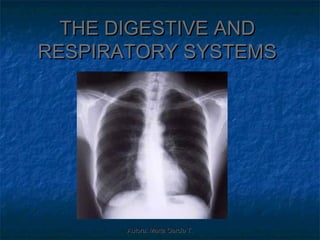
Digestrespir
- 1. THE DIGESTIVE AND RESPIRATORY SYSTEMS Autora: Marta García T.
- 2. HUMAN NUTRITION NUTRITION is the set of processes that allows the body to obtain from food the substances (nutrients) needed to live, transport them through the body, and eliminate the toxic substances produced by our cells when using those nutrients. Autora: Marta García T.
- 3. SYSTEMS INVOLVED IN NUTRITION Autora: Marta García T.
- 4. Autora: Marta García T.
- 5. SYSTEMS INVOLVED IN NUTRITION Digestive System: transforms food into nutrients which can be used by our cells. Respiratory System: captures oxygen and eliminates carbon dioxide. Circulatory System: transports substances through the body. Excretory System: eliminates waste susbtances produced by our cells. Autora: Marta García T.
- 6. DIGESTIVE SYSTEM Autora: Marta García T.
- 7. It transforms food into simpler useful substances (nutrients ) so that cells can use them, and eliminates the non digestive leftovers. Autora: Marta García T.
- 8. Elements of the Digestive System Digestive Tract: 8 metres long, from mouth to anus. Accesory Glands: release substances into the digestive tract: Salivary Glands. Gastric Glands. Intestinal Glands. Liver. Pancreas. Autora: Marta García T.
- 9. Autora: Marta García T.
- 10. Autora: Marta García T.
- 11. DIGESTIVE PROCESSES Ingestion: taking in food. Mouth. Digestion: decomposing food into simpler substances (nutrient) which can be used by our cells. Mouth, stomach, small intestine. It can be: Mechanical Digestion. Chemical Digestion. Absorption: nutrients pass to the blood. Small intestine. Egestion: expelling non-digested susbtances. Large intestine. Autora: Marta García T.
- 12. DIGESTION We take in food through the mouth, where digestion starts: - Mechanical: Teeth (mastication) and Tongue (helps the food bolus to be formed). - Chemical: Insalivation: amylase in saliva starts digesting glucids. FORMATION OF THE FOOD BOLUS Autora: Marta García T.
- 13. Autora: Marta García T.
- 14. SWALLOWING The tongue movements cause swallowing. The food bolus passes through the pharynx to the oesophagus. Once in the oesphagus, peristaltic movements lead the bolus to move downwards to the stomach. Autora: Marta García T.
- 15. STOMACH Both mechanical and chemical digestion take place in the stomach. Autora: Marta García T.
- 16. Digestión Química: El estómago segrega jugos gástricos, sustancias químicas ácidas que atacan y descomponen el alimento. Digestión Física: Las paredes del estómago tienen tejido muscular, lo que permite que realice movimientos que contribuyen a mezclar el bolo con los jugos gástricos. La mezcla que sale del estómago se denomina QUIMO (Chyme), y atraviesa el cardias para llegar al intestino delgado. Autora: Marta García T.
- 17. SMALL INTESTINE It is about 6-7 metres long. It has three sections : Duodenum. Jejunum. Ileum. Autora: Marta García T.
- 18. En el Duodeno continúa la digestión química del alimento, por parte de tres sustancias: Los jugos intestinales que segregan las propias paredes del duodeno. La bilis, que es segregada por el hígado y vertida al duodeno. Los jugos pancreáticos, que son segregados por el páncreas y vertidos al duodeno. Autora: Marta García T.
- 19. Tras su paso por el duodeno, el alimento ya está descompuesto totalmente en nutrientes, formando una pasta que llamamos QUILO (Chyle). Los nutrientes serán absorbidos por la sangre en los dos tramos siguientes del intestino delgado (yeyuno e íleon), y serán transportados a todas las células. Autora: Marta García T.
- 20. Autora: Marta García T.
- 21. LARGE INTESTINE Once digestion is finished, undigested food passes to the large intestine. Here, water and mineral salts are reabsorbed. Waste products are compacted to form faeces, which are expelled through the anus. It has three sections: - Caecum. - Colon. - Rectum. Autora: Marta García T.
- 22. Match each organ with its function. Autora: Marta García T.
- 23. http://www.edistribucion.es/anayaeducacion/8440042/U03_SC3/02_Digestive%2 Autora: Marta García T.
- 24. RESPIRATORY SYSTEM Autora: Marta García T.
- 25. Through respiration our body gets the oxygen needed by all cells to burn nutrients and produce the energy they need. At the same time, this process allows us to expell the carbon dioxide our cells have produce when burning nutrients. The respiratory system is made up of: The airways. The lungs. Autora: Marta García T.
- 26. Autora: Marta García T.
- 27. Nasal Cavity (Warms and cleans the air) Epiglottis Pharynx Larynx Bronchioles Trachea Lungs Bronchi Pulmonary alveoli Autora: Marta García T.
- 28. Autora: Marta García T.
- 29. Recorrido del aire en el sistema respiratorio Autora: Marta García T.
- 30. GAS EXCHANGE Aire espirado Aire inspirado Sangre rica en Sangre pobre oxígeno en oxígeno y rica en CO2 Oxígeno CO2 Autora: Marta García T.
- 31. PULMONARY VENTILATION Diaphragm moves down, and the ribs move up and out. The air enters Thoracic the lungs cavity gets smaller, and the air is expelled from Thoracic cavity the lungs Diaphragm gets bigger, and relaxes and the lungs fill with moves up, and air. the ribs move down and in. INSPIRATION EXPIRATION Autora: Marta García T.
- 32. Composición del aire inspirado y espirado. AIRE INSPIRADO AIRE ESPIRADO 21% 17% 4% 0.03% Oxígeno Dióxido de Oxígeno Dióxido de carbono carbono Autora: Marta García T.